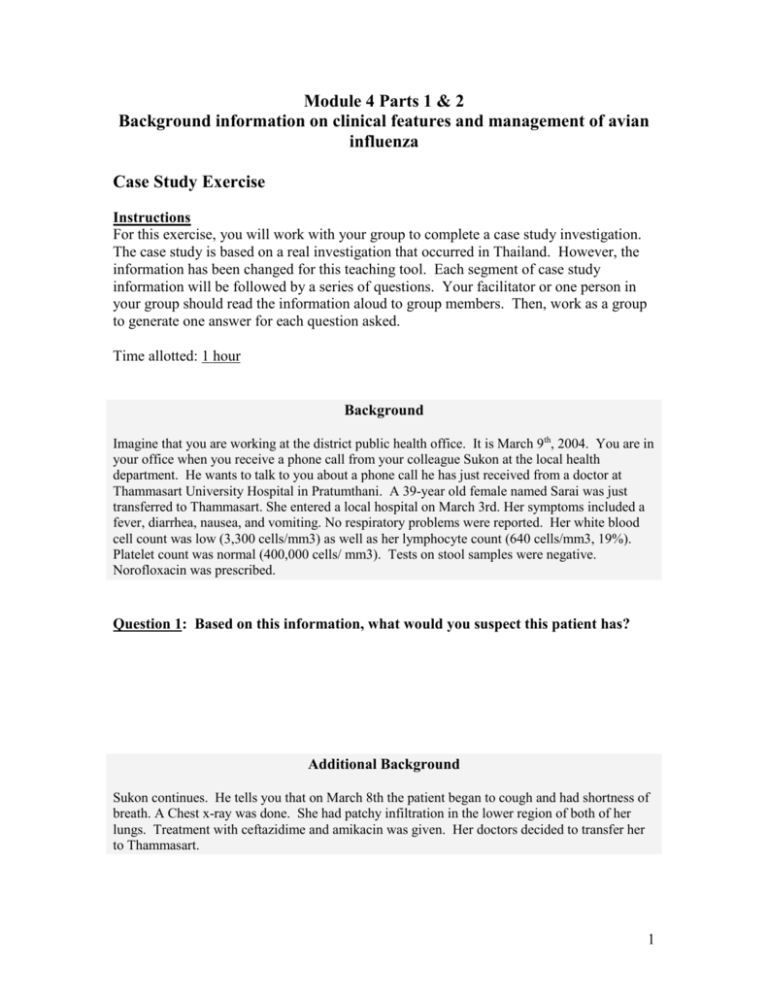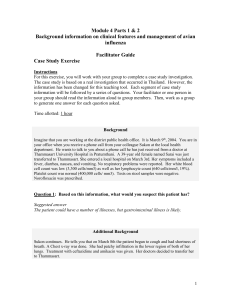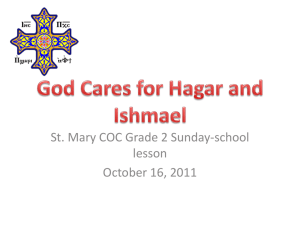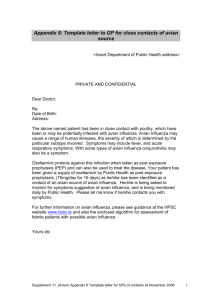Trainee`s Exercises - UNC Center for Public Health Preparedness
advertisement

Module 4 Parts 1 & 2 Background information on clinical features and management of avian influenza Case Study Exercise Instructions For this exercise, you will work with your group to complete a case study investigation. The case study is based on a real investigation that occurred in Thailand. However, the information has been changed for this teaching tool. Each segment of case study information will be followed by a series of questions. Your facilitator or one person in your group should read the information aloud to group members. Then, work as a group to generate one answer for each question asked. Time allotted: 1 hour Background Imagine that you are working at the district public health office. It is March 9th, 2004. You are in your office when you receive a phone call from your colleague Sukon at the local health department. He wants to talk to you about a phone call he has just received from a doctor at Thammasart University Hospital in Pratumthani. A 39-year old female named Sarai was just transferred to Thammasart. She entered a local hospital on March 3rd. Her symptoms included a fever, diarrhea, nausea, and vomiting. No respiratory problems were reported. Her white blood cell count was low (3,300 cells/mm3) as well as her lymphocyte count (640 cells/mm3, 19%). Platelet count was normal (400,000 cells/ mm3). Tests on stool samples were negative. Norofloxacin was prescribed. Question 1: Based on this information, what would you suspect this patient has? Additional Background Sukon continues. He tells you that on March 8th the patient began to cough and had shortness of breath. A Chest x-ray was done. She had patchy infiltration in the lower region of both of her lungs. Treatment with ceftazidime and amikacin was given. Her doctors decided to transfer her to Thammasart. 1 Question 2: Do you think that Sarai has influenza (human or avian)? Current Condition When Sarai arrived at Thammasart, her new doctor checked her health again. She had a fever of 39.4 C and a high respiratory rate, 44 per minute. Her heart rate was also high, 140 beats per minute. Her blood pressure was 110/80 mm Hg. Her doctor decided to intubate her. He could also hear a crackling noise when she breathed. Laboratory tests on her blood found a drop in white blood cell count. Lymphocyte count was low as well. Platelet count was normal. The clinical profile indicated she was developing acute respiratory distress syndrome. Sarai’s doctor gave her imipenem, azithromycin, and doxycycline. Question 3: To date, which symptoms might indicate human influenza infection? Which symptoms might indicate avian influenza H5N1 infection? Question 4: Sukon asks you, “What do you think? Could this be avian influenza H5N1?” Why or why not? What other information would you like to know? 2 H5N1 Activity You tell Sukon you would like to get a little more information and ask him to contact Sarai’s husband. At the same time, you begin to do a little investigation to learn more about the H5N1 activity in Thailand. You learn that as of January 23rd, 2004, Thailand had reports of two laboratory confirmed cases of human infection with H5N1. Sporadic cases were also reported through mid March of 2004. Question 5: How is this information helpful for you? Exposure As you finish reading about H5N1 in Thailand, Sukon calls you. He has just spoken to Sarai’s husband Niran. Sukon has learned that Sarai lives in a rural area in central Thailand. A total of five people live at home but no one else in the family is sick. Niran told Sukon that there were several dead chickens in the neighborhood. The chickens would often come to the house. Sarai told Niran that a few of the chickens died in front of the house. She had collected the chickens and returned them to her neighbors. Question 6: Do you think Sarai is at risk for avian influenza H5N1 infection? If yes, why? Question 7: What evidence do you have that Sarai has avian influenza H5N1 infection? 3 Testing Sukon and you agree that Sarai may have avian influenza H5N1. You advise Sukon to have nasal and pharyngeal specimens collected for testing. You also suggest that Sukon speak with Sarai’s doctor. It is important that Sarai’s doctors and nurses wear proper droplet and contact precautions to protect themselves. You or other public health officials should contact Sarai’s neighbors with the dead chickens and investigate them for signs of illness. Question 8: What suggestion do you offer for Sarai’s care? Conclusion The rapid influenza test was negative. Due to limited access to antiviral medication, Sarai’s doctor could not give oseltamivir or zanamivir. Intravenous prednisone was started for Sarai. Unfortunately she began to have organ failure and died the next day. Based on clinical features and information about Sarai’s exposure to birds, you were able to appropriately suspect that she had avian influenza H5N1 infection. Laboratory testing would later confirm your suspicions. Nasopharyngeal specimens that were collected were positive by reverse transcriptase-polymerase chain reaction (RT-PCR) for H5N1. You also learned that dead chickens near Sarai’s home tested positive for H5N1. 4 Module 4 Part 2 Case Management of Suspect Human Avian Influenza Infection: Advising on Case Management Role Playing Exercise Instructions. The purpose of this exercise is to help trainees learn how to collect the pieces of data that are important for an outbreak investigation yet may be missing from medical charts. Trainees will work in pairs and choose one of two roles to play in an outbreak investigation: one student will be the patient, and the other will be the investigator working on a rapid responder team for the Ministry of Health. You will have 15 minutes to work on this exercise. 5 Patient Role Play Information Sheet You are to play an ill patient in a local hospital being interviewed by someone from the Ministry of Health. Acting the role can make this fun- you should be ill appearing, perhaps annoyed by the questioning, coughing and having trouble breathing, or may be difficult to interest in the questioning. If you are asked questions for which you do not have information, feel free to improvise an answer. Demographic information Country specific: Please adapt demographic information to your country Name: made up gender neutral name in native language Age: 14 Gender: based on gender of role player Occupation: student Address: made up location History of illness: You began to feel ill 8 days ago with the sudden onset of headache, stomach upset, fever and cough. Your health began to get worse over the next 72 hours with profuse diarrhea, worsening cough and shortness of breath, and fevers to 39° C. Your concerned parents brought you to the local hospital for evaluation and treatment on day 4 of the illness. Exposure history: You are a student, and your parents are farmers in a rural area outside a large village. You do not smoke. Your neighbors raise chickens, and you play on their property regularly. Reports of unexpected bird deaths in the area have included your neighbors’ chickens. You have not traveled recently, and you do not know of any ill contacts at school or anywhere else that have symptoms similar to yours. Medical history: You were previously healthy, and your immunizations are up to date. Family history: You have 4 siblings, and all have recently been healthy. Neither your mother and father nor your siblings have chronic medical problems. 6 Investigator / Rapid Responder Role Play Information Sheet You are a regional outbreak investigator for the Ministry of Health, and you have been asked to interview an ill teenager in your territory. Your objective is to obtain pertinent data for a possible avian influenza outbreak investigation. It might be helpful to review your lecture notes to review the kind of data that may be most helpful in an outbreak investigation like this. A sample questionnaire is provided on the next page to help prompt you for missing pieces of data. However, you may think of additional questions to ask of the patient. Known facts from medical chart review: Country specific: Please adapt demographic information to your country Name: Age: Gender: Occupation: Address: made up gender neutral name in native language 14 based on gender of role player Student made up location History of Illness Patient is a 14 year-old with a recent history of fever, respiratory problems, and diarrhea. Patient was admitted 4 days ago. Medical history: previously healthy, immunizations up to date Family history: mother, father, siblings have no chronic medical problems Physical Examination Findings: Temp: 38.5° C; Respiratory rate: 42; Pulse: 130; Blood Pressure: 90/60 General: somewhat uncomfortable appearing with rapid respirations, cough Heart: tachycardic Lungs: fine crackles in most of lung fields Labs: Blood count: Total Leukocytes: 3000/ mm3 Lymphocytes: 800/mm3 Hemoglobin: 12.4 g/dl Platelets: 124000/mm3 AST 237 u/l ALT 385 u/l Chest x-ray: patchy bilateral infiltrates Current medications: oxygen, paracetamol, ceftriaxone, gentamycin 7 Date _____ SAMPLE PATIENT QUESTIONNAIRE Demographic Information Name ___________________________ Age ____ Gender ___ Occupation_______ Address______________________________________________________ History of Illness Chief Complaint_____________________ Date of Illness Onset _________________ Other Symptoms and symptom onset date: _______________________________________________________ _______________________________________________________ Physical Exam Findings _______________________________________________________ _______________________________________________________ Lab findings _______________________________________________________ _______________________________________________________ Exposure History Contact with ill people? (If yes, date and name, relationship to patient) _______________________________________________________ _______________________________________________________ Contact with diseased poultry (live or dead)? (If yes, date and location) _______________________________________________________ _______________________________________________________ Recent travel? (If yes, date and location) _______________________________________________________ _______________________________________________________ Other close patient contacts (Household members, close coworkers) _______________________________________________________ _______________________________________________________ 8






